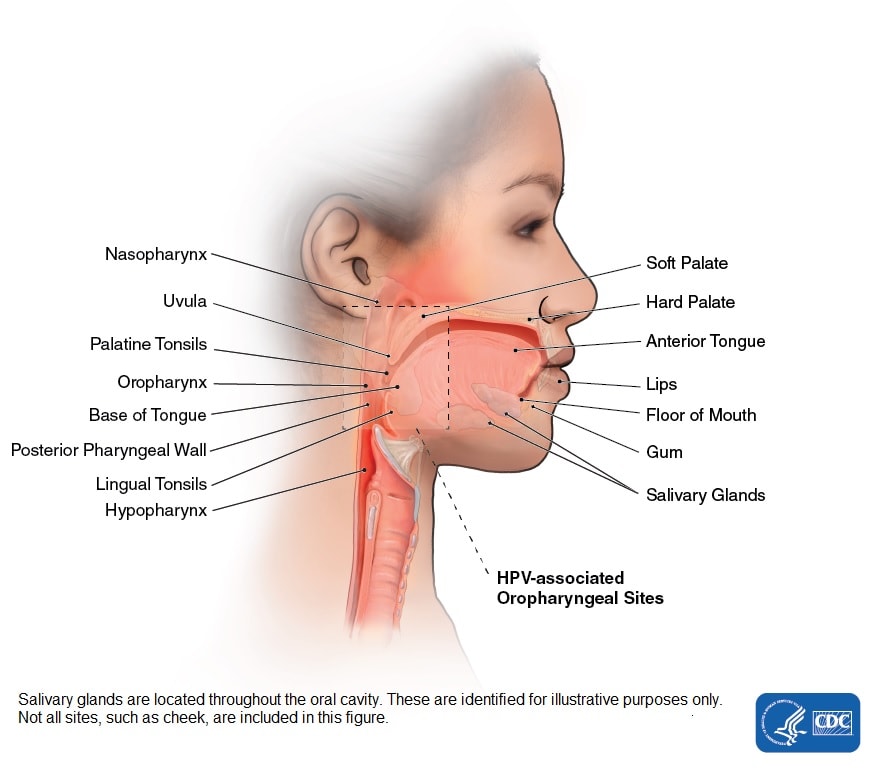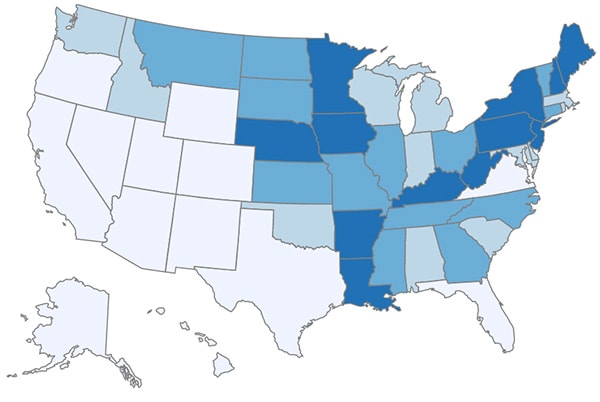Head and Neck Cancers

This illustration shows the location of the nasopharynx, uvula, palatine tonsils, oropharynx, base of tongue, posterior pharyngeal wall, lingual tonsils, hypopharynx, soft palate, hard palate, anterior tongue, lips, floor of mouth, gum, salivary glands, and HPV-associated oropharyngeal sites.
Note: Salivary glands are located throughout the oral cavity. These are identified for illustrative purposes only. Not all sites, such as cheek, are included in this figure.
Cancer is a disease in which cells of the body grow out of control. Cancers of the head and neck include cancers that start in several places in the head and throat, not including brain cancers or cancers of the eye.
These cancers can start—
- In the sinuses (the spaces around the nose on the inside of the skull).
- Inside and behind the nose.
- In the mouth, including the tongue, the gums, and the roof of the mouth.
- In the back of the mouth and the throat (pharynx), which includes three sections called the nasopharynx, oropharynx, and hypopharynx.
- In the larynx (voice box).
- On the lips, although cancer on the lips is a type of skin cancer.
- In the glands that make saliva for the mouth, but those are relatively rare.
To lower your risk for head and neck cancers, don’t use tobacco products, limit the amount of alcohol you drink, avoid indoor tanning, and talk to your doctor about HPV vaccination.
What Are the Symptoms of Head and Neck Cancers?
In the mouth, cancer can cause—
- A white or red sore that does not heal on the gums, tongue, or lining of the mouth.
- Swelling in the jaw.
- Unusual bleeding or pain in the mouth.
- A lump or thickening.
- Problems with dentures.
At the back of the mouth (pharynx), cancer can cause—
- Trouble breathing or speaking.
- A lump or thickening.
- Trouble chewing or swallowing food.
- A feeling that something is caught in the throat.
- Pain in the throat that won’t go away.
- Pain or ringing in the ears or trouble hearing.
In the voice box (larynx), cancer can cause—
- Pain when swallowing.
- Ear pain.
In the sinuses and nasal cavity, cancer can cause—
- Blocked sinuses that don’t clear.
- Sinus infections that do not respond to treatment with antibiotics.
- Bleeding through the nose.
- Headaches.
- Pain and swelling around the eyes.
- Pain in the upper teeth.
- Problems with dentures.
What Causes Head and Neck Cancers?
Alcohol and tobacco are major risk factors for cancers of the head and neck. All tobacco products, including cigarettes, cigars, pipes, and smokeless tobacco (chewing tobacco, snuff, or a type of chewing tobacco called betel quid) are linked to head and neck cancer (except for salivary gland cancers). Drinking any type of alcohol, such as beer, wine, or liquor, also raises the risk of getting cancers of the mouth, throat, and voice box.
About 70% of cancers in the oropharynx (which includes the tonsils, soft palate, and base of the tongue) are linked to human papillomavirus (HPV), a common sexually transmitted virus.
Overexposure to ultraviolet (UV) rays from the sun, tanning beds, or sunlamps is a cause of cancer on the lips.
Occupational exposures, or being exposed to certain substances while on the job, can increase the risk of getting cancers in the nasopharynx. Working in the construction, textile, ceramic, logging, and food processing industries can cause people to be exposed to substances like wood dust, formaldehyde, asbestos, nickel, and other chemicals.
An infection with the Epstein-Barr virus, a cause of infectious mononucleosis and other illnesses, can raise the risk of cancers in the nose, behind the nose, and cancers of the salivary glands.
Radiation treatments to the head and neck can cause head and neck cancers.
About twice as many men as women get head and neck cancers. They are more likely to be diagnosed in people who are over 50 years of age.

After Lewis was diagnosed with throat cancer, he and his wife Amy started a support group for people with head and neck cancers. Read his story.
How Can I Reduce My Risk for Head and Neck Cancers?
You can lower your risk of getting head and neck cancer in several ways—
- Don’t smoke. If you smoke, quit. Quitting smoking lowers the risk for cancer.
- Don’t use smokeless tobacco products.
- Limit the amount of alcohol you drink.
- Talk to your doctor about HPV vaccination. The HPV vaccine can prevent new infections with the types of HPV that most often cause oropharyngeal and other cancers. Vaccination is recommended only for people at certain ages.
- Use condoms and dental dams consistently and correctly during oral sex to lower the chances of giving or getting HPV.
- Use lip balm that contains sunscreen, wear a wide-brimmed hat when outdoors, and avoid tanning.
- Visit the dentist regularly. Checkups often can find head and neck cancers early, when they are easier to treat.
Statistics
The following statistics apply to cancers of the oral cavity and pharynx, which includes cancers of the lip, tongue, mouth, pharynx, and tonsils.
The Data Visualizations tool makes it easy for anyone to explore and use the latest official federal government cancer data from United States Cancer Statistics. It includes the latest cancer data covering the U.S. population.
More Information
- HPV and Oropharyngeal Cancer
- Head and Neck Cancers (National Cancer Institute)


